2022.07.04.4
Files > Volume 7 > Vol 7 No 4 2022
Leg cuts from Awaasi lambs fed a diet with varying levels of Rhus coriaria L., Physical dissection and chemical composition.
Maysaloon W. Ibraheem1*, Ahmed R. Muhaimeed1 and Th. T. Mohammed2
1Department of Animal Production, Agriculture College, Tikrit University, Iraq.
2Department of Animal Production, College of Agriculture, University of Anbar, Anbar, Iraq.
*Author for correspondence : E-mail: [email protected]
Available from: http://dx.doi.org/10.21931/RB/2022.07.04.4
ABSTRACT
This research was conducted in a private slaughterhouse in Samarra from 1/5/2019 to 1/8/2019. Sixteen Awassi lambs were raised with an average body weight (of 20±25) kg and an age of about (5.5 to 6) months. We divided the lambs into four treatments. The first treatment was without additives, called control; the second treatment was 1% Sumac, the third treatment was 3% Sumac, and the last one was the fourth treatment with 5% Sumac. The results showed significant differences between treatments in biceps femoris and semimembranosus muscle (treatment 3 the female) were (180.9±10.66)g, ( 168.4±5.72)g respectively. And a highly significant difference in adductor muscle (treatment 3, the female) was (75.6±2.58)g compared with the control (62.85±5.93)g. significant differences in treatment 3 in Semitendinosus muscle between males and females were( 57.2±3.65) and (74.4±3.02)g, respectively. The rectus femurs showed significant differences between treatments 3 and 4 in females were( 99.6±8.76) and (76.3±6.98)g, respectively. In physical dissection, a low significant difference in treatment 4 in lean was (56.3+3.66)%. The lean percentage in treatment 3 of the female was (59.2±0.99) %. About chemical analysis, the high percentage of moisture in the male in treatments 2,3 and 4 were (72.7±0.14),( 72.8±0.21),(and 72.8±0.21)%, respectively.
Keywords: leg cut, physical dissection, Rhus Coriaria L.
INTRODUCTION
Because medical plants have demonstrated the effect on human and animal life activities, the world has moved towards using them as a therapeutic material instead of chemical compounds.
The most important source of red meat in Iraq is sheep, so they are raised in big farms by breeders; the ease with which they have raised increases where it is known by their short and rapid production cycle; it also has a high growth rate compared with other ruminants1-2. and raising the income of societies caused changes in the requirements of consumers they started looking forward to getting wholesome and healthy quality meat 3 . As we know, nutrition is the essential factor causing the excellent performance of raised animals 4.
Because medical plants have demonstrated the effect on human and animal life activities, the world has moved towards using them as a restorative material instead of chemical compounds 5-6.
Their use is harmful side effects, especially on some body organs such as the liver, pancreas, kidneys, etc., along with its apparent impact on the body's immune system; after the experiments on poultry, the researchers moved to ruminants to study these medicinal plants on the performance of ruminants, tiny ones like sheep and goats 7-8 on of these plants is Rhus Coriaria L. it was used in this research as natural growth stimuli.
MATERIALS AND METHODS
This research was conducted in a private slaughterhouse in Samarra called (good land farm) sixteen Awassi lambs were raised (individual cages) with average body weight (of 20±25)kg their age (of 5.5-6) months. The lambs have divided into four treatments according to the additive: the first treatment was control without sumac, the second treatment was 1% sumac, the third treatment was 3% Sumac, and the last treatment was the fourth 5% Sumac. The cages were supplemented with a feeder and utensils of drinking water; the mineral salt block was in front of the lambs
Dietary treatment
A typical diet given to the lambs consisted of barley, wheat bran, soybeans, yellow corn, salts and minerals. The barley was the most significant percentage, then the wheat bran
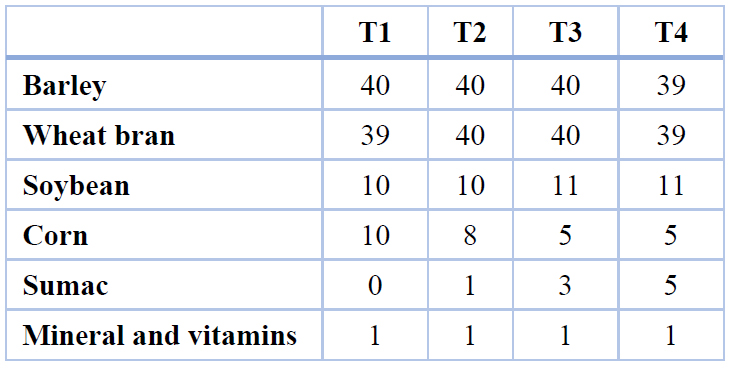
Table 1. Experiment with diet ingredients percentage
Lamb slaughter
At the end of the experiment, the lambs fasted from food only for 12 hours, then they were slaughtered, and we put the carcass in the fridge at 4 C for 24 hours; the next day, we took the leg cut off the carcass right half to do the measurements
Physical dissection
It was performed in the laboratory, where the lean was separated from the fat and bone; also the leg muscles were separated according to the scientific method of separating using the dissection substances
Chemical examination
Determination of moisture, protein content, fat and ash was done according to 9
Panel test
Sensory evaluation of the leg cut was performed by the method of 10. A group of people was selected from the faculty of Agriculture in the department of animal production who were experienced in judging meat samples and evaluating them in terms of tenderness, juiciness, flavor and general acceptance by cooking the samples at 165⁰ C in the oven for 20 minutes. The judges were provided with detailed information about the grade of each trait before the test began
Statistical analysis
The statistical analysis of the data was done using the complete random design (CRD) to study the effect of parameters on different characteristics 11. The significant differences between the average were compared by using the Duncan test 12. in the following linear additive model :

Where:
Yij: the observation of additives
µ : is the overall mean effect
Tj : effect of treatment
eijk : is independent normally distributed random error term zero mean and variance δ²
RESULTS
Leg weight and muscles
The results in a table (2) showed significant differences between treatment in biceps femoris and semimembranosus muscle (treatment 3 the female) were (180.9±10.66)g,( 168.4±5.72)respectively. And the highly significant difference in adductor muscle (treatment 3, the female) was (75.6±2.58)g compared with the control (62.85±5.93)g; the reason may be due to the high weight of the leg in treatment 3 compared with the other treatments. At the same time, gracilis muscle did not show significant differences between the four treatments.
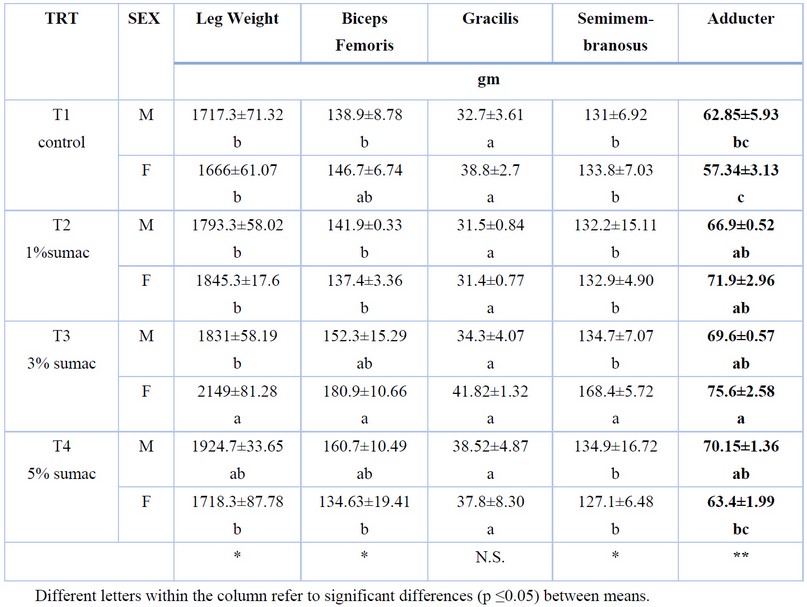
Table 2. Effect of different treatments and sex on leg weight and muscles (mean ± S.E)
Leg muscle weight
The results in( table 3 )showed significant differences in treatment 3 in Semitendinosus muscle between males and females ( 57.2±3.65) and (74.4±3.02)g, respectively; the reason may be due to the chemical composition. Also, the rectus femurs showed significant differences between treatments 3 and 4 in females were( 99.6±8.76) and (76.3±6.98) g, respectively
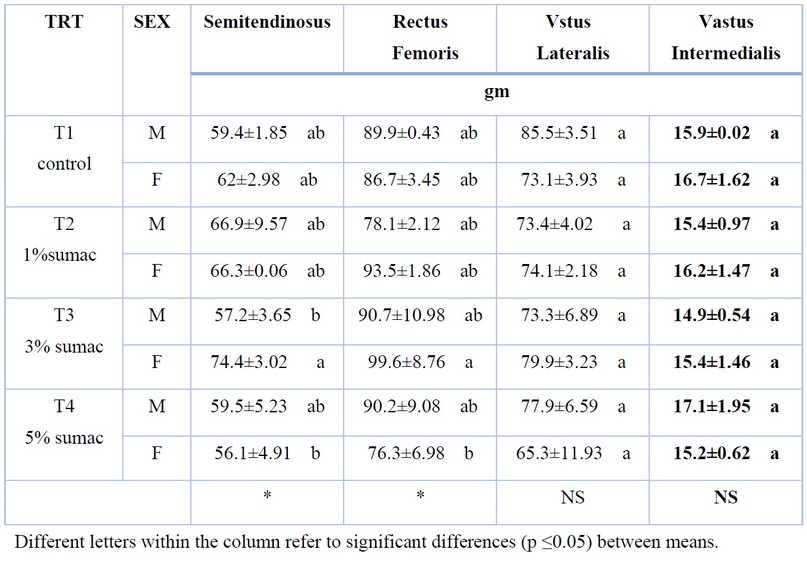
Table 3. Effect of different treatments and sex on leg muscles weights (mean ± S.E)
Physical dissection
The results of physical dissection in( table 4) showed a low significant difference in treatment 4 in lean, it was (56.3±3.66)%, while the lean percentage in treatment 3 the female was (59.2±0.99)%; the reason may be due to the high percentage of fat in the same treatments and that is because of the inverse relationship between protein and fat, and that would explain the high percentage of fat in treatment 4 the female it was (23.8+ 3.77) % also it is may be due to the Sumac additives in this treatment.
For bone, the best percentage was conducted by treatment3and 4 the female; it was the minor percentage between the four treatments were( 19.7±1.12) and (19.9±0.24) %, respectively
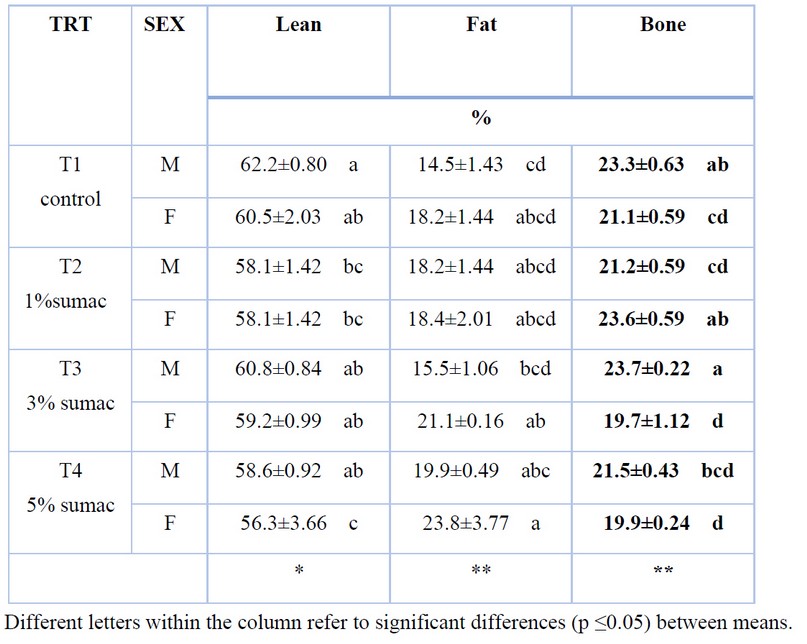
Table 4. Effect of different treatments and sex on physical dissection components (mean ± S.E)
Chemical composition
The results of chemical composition explain a lot. (table 5) the high percentage of moisture in the male in treatments 2,3 and 4 were (72.7±0.14),( 72.8±0.21),(and 72.8±0.21)% respectively, while the low percentage was in the female in the same treatments they were (72.1±0.17), (72.0±0.05), (72.0±0.03)% respectively the reason may be due to the differences in genetic structures between male and female sheep.
Regarding protein, the significant differences were minor for treatment 4, the male; it was (22.7±0.20) %; as we know, protein is the least variable in the chemical composition of meat.
We noticed the differences were evident in fat percentage, especially in treatment 2,3; the female was (3.6) %; the reason may be due to the reverse between fat and moisture.
Ash showed highly significant differences in treatment 4; the male was the best conducted( 0.6±0.11) % while the female in the same treatment conducted (1.6±0.07)%
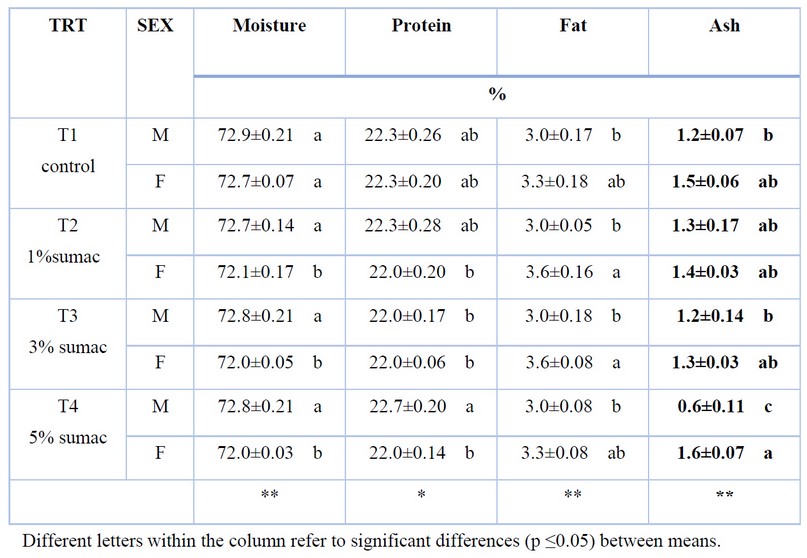
Table 5. Effect of different treatments and sex on semimembranosus chemical composition (mean ± S.E)
Panel test
The sensory evaluation of the semimembranosus muscle from the leg cut showed significant differences in flavor in treatments 3 and 4 in males (4.3). Also, juiciness was conducted a highly significant difference in the same treatments ( 4.6±0.33)
Regarding the acceptability and tenderness treatment 4, the female was the best. It conducted 4.6 and( 4.0) respectively, maybe that the addition of sumac affected the sensory evaluation in treatments 3 and 4
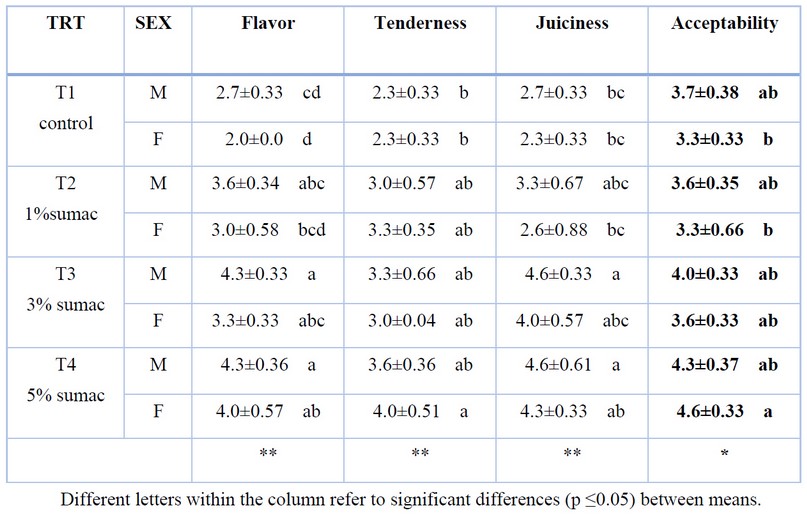
Table 6. Effect of different treatments and sex on semimembranosus sensory evaluation (mean ± S.E)
DISCUSSION
Leg weight and muscles
From the results of table 2, we noticed that adding 3% sumac to ewes diets could be helpful to increase semimembranosus muscle, which is very useful for predictors and consumers because both prefer an increase in lean percentage than fat and bone ratio. The rise of the semimembranosus muscle increased leg muscle because of a high rate of the mentioned muscle compared with the others, so it is a significant and valuable increase 2. Maybe this addition of sumac to the diets would be helpful too because it involves a reasonable amount of sumac, as it doesn't negatively affect other treatments.
Leg muscle weight
As for the rest thigh muscles, adding 3% sumac to the ewe's diets positively affected the semitendinosus and rectus femoris muscles. The high proportion of each muscle in the leg cut is economically essential 4, as the leg is one of the primary cuts of the carcass, and the high proportion of meat is always the goal of the breeders and the consumer
Physical dissection
By physical dissection of the leg, it can be inferred that the addition of sumac affected the third and fourth treatments, which resulted in an increase in fat percentage in the fourth treatment, which is a non-positive indicator 4. The permanent goal is to increase the proportion of lean in the carcass, not fat. Adding sumac may cause undesirable variations in the overall physical dissection. However, expanding the tissue of some leg muscles in the female and male sheep is positively affected by the sumac adding, not the physical dissection.
Chemical composition
On the chemical analysis of the leg, the differences in each characteristic between the parameters and even between the animal gender are unmistakable. But in general, we saw high moisture in all treatments with high protein. Because of the inverted relationship between moisture and fat, it was shallow in most treatments. This is a reassuring indicator of the possibility of using sumac in general animals. 2 The primary desire of both producer and the consumer is a high protein, low-fat meat. This is evident from the results of this research.
Panel test
The second and third treatments had the best results in the panel test, although the proportion of meat composition varied between treatments. This differentiation of the third and fourth treatments is reassuring since the juiciness and tenderness are critical qualities on which meat can be classified and graded. The high tenderness of the two treatments above is a good indicator 10 and may contribute even a tiny part to improving the qualities of the sensory meat.
CONCLUSIONS
This research concludes that sumac can be used in male and female sheep diets, as it contributes to a lower fat content, increase the nutritional value of the meat also, indirectly preserves it from decay and oxidation, and improve the sensory qualities of the meat, meaning its smoothness and juices.
REFERENCES
1. Ahmad, A. Sh., F.T. Al-Rawi, Y.T. Abdul-Rahaman, TH. T. Mohammed, K.I. Mahmud.. Effect of Tryptophan injection on the semen quality in Iraqi Shami buck. IOP Conference Series: Earth and Environmental Science, 2021, 761(1), 012093.
2. AlQudsi, N.; H.; Taha, S.; A.; Abo, N.; Y.; Abdullah, M.; N.; Effect of using some medicinal herbs on enhanced Awassi sheep. Egyption Journal of Nutrition and Feed ,2000. vol(12) p.(227-237).
3. Salman, I; Hassen, Salih, H; Hasson. The effect of natural additives rich in Katkins and Lycopene compounds on some physical and lipid properties and the colour of frozen buffalo meat. Anbar Journal of Veterinary Science.2012, Vol(5) : No.1 :38-49.
4. Hshem, A.L.S; Shakir, Y.M; Abdel-Fattah, M.S;Hanan, Z. and Ashgan, M.E.. Effect of weaning age on growth performance and carcass traits of Barkilambs in SiwaQasis, Egypt. World Applied Sci. J.,2013, 21:975-982.
5. Saad alden, SH.; M.; (1986) Medicinal herbs. Culture affairs, culture and media, page (1).
6. Najim, Y. S., Mohammed, Th. T. & Al-Khalani, F. M. H. The effect of the use of different levels of Azolla to male broilers diets in the production and physiological performance and economic feasibility. Biochemical and Cellular Archives.2020 20(1): 573-580. Doi: 10.35124/bca.2020.20.1.573
7. S. M. Abdulateef, O. K. Atalla1, M. Q. A L-Ani, TH. T Mohammed, F M Abdulateef And O. M. Abdulmajeed. Impact of the electric shock on the embryonic development and physiological traits in chicks embryo. Indian Journal of Animal Sciences.2012, 90 (11): 1541–1545
8. Othman, S; Suleman.(2016). The effect of ginger extract on the characteristics of beef , Complementary ,research for a Degree Honors , College of Animal science, Khartoum, Sudan
9. AOAC . Official methods of analysis of the Association of Official Analytical Chemists. 1999,2 vols. 15th ed. Washington, DC.
10. Price, J. F., and B. S. Schweigert, (1971). Page 371 in Science of meat and meat products. W. H. Freeman and Co., San Francisco, CA.
11. SAS. 2001. SAS Users Guide: Statistics (version6.0) SAS Inst. Inc. Cary, NC, USA.
12. Duncan, D. B. "t Tests and Intervals for Comparisons Suggested by the Data." Biometrics, 1975,31:339–359.
Received: 20 July 2022 / Accepted: 15 October 2022 / Published:15 November 2022
Citation: Ibraheem M W, Muhaimeed A R, Mohammed Th T. Leg cuts from Awaasi lambs fed a diet with varying levels of Rhus coriaria L., Physical dissection and chemical composition. Revis Bionatura 2022;7(4) 4. http://dx.doi.org/10.21931/RB/2022.07.04.4
